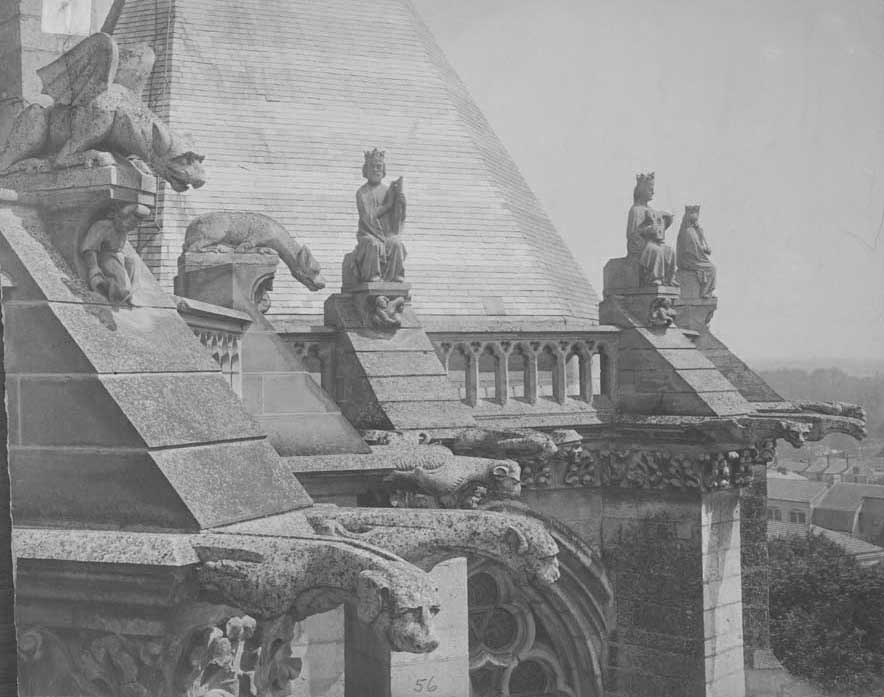

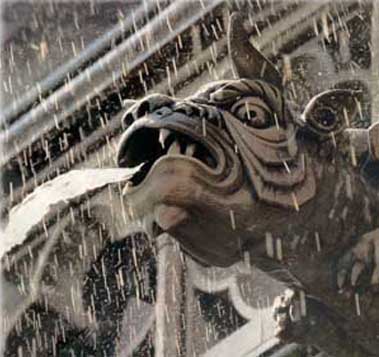
In architecture, a gargoyle is a carved stone grotesque with a spout designed to convey water from a roof and away from the side of a building. Preventing rainwater from running down masonry walls is important because running water erodes the mortar between the stone blocks.
Architects often used multiple gargoyles on buildings to divide the flow of rainwater off the roof to minimize the potential damage from a rainstorm. A trough is cut in the back of the gargoyle and rainwater typically exits through the open mouth. Gargoyles are usually an elongated fantastic animal because the length of the gargoyle determines how far water is thrown from the wall. When Gothic flying buttresses were used, aqueducts were sometimes cut into the buttress to divert water over the aisle walls.
The term originates from the French gargouille, originally "throat" or "gullet"; cf. Latin gurgulio, gula, gargula ("gullet" or "throat") and similar words derived from the root gar, "to swallow", which represented the gurgling sound of water (e.g., Spanish garganta, "throat"; Spanish gárgola, "gargoyle"). It is also connected to the French verb gargariser, which means "to gargle." The Italian word for gargoyle is doccione o gronda sporgente, an architecturally precise phrase which means "protruding gutter." The German word for gargoyle is Wasserspeier, which means "water spewer." The Dutch word for gargoyle is waterspuwer, which means "water spitter" or "water vomiter." A building that has gargoyles on it is "gargoyled."
Gargoyles are said to scare off and protect from any evil or harmful spirits.
A grotesque figure is a sculpture that does not work as a waterspout and serves only an ornamental or artistic function. These are also usually called gargoyles in layman's terminology, although the field of architecture usually preserves the distinction between gargoyles (functional waterspouts) and non-waterspout grotesques.
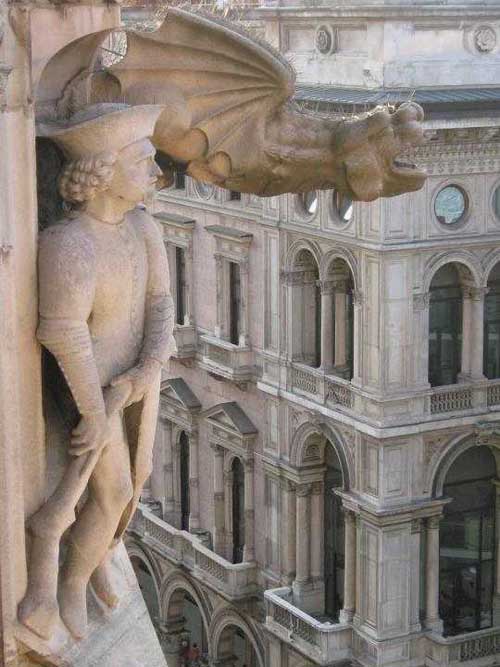
Chimeras are creatures that are mixes of different types of animal body parts to create a new creature. Some of the more notable chimeras are griffins, centaurs, harpies, and mermaids. Chimeras often served as a warning to people who underestimated the devil.
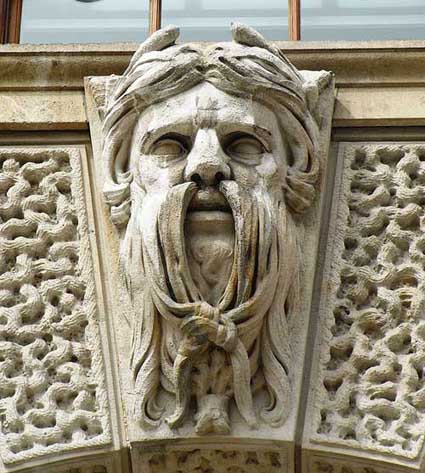
Grotesques are often confused with gargoyles, but the distinction is that gargoyles are figures that contain a water spout through the mouth, while grotesques do not. This type of sculpture is also called a chimera. Used correctly, the term gargoyle refers to mostly eerie figures carved specifically as terminations to spouts which convey water away from the sides of buildings. In the Middle Ages, the term babewyn was used to refer to both gargoyles and grotesques. This word is derived from the Italian word babuino, which means "baboon".
The term gargoyle is most often applied to medieval work, but throughout all ages some means of water diversion, when not conveyed in gutters, was adopted.
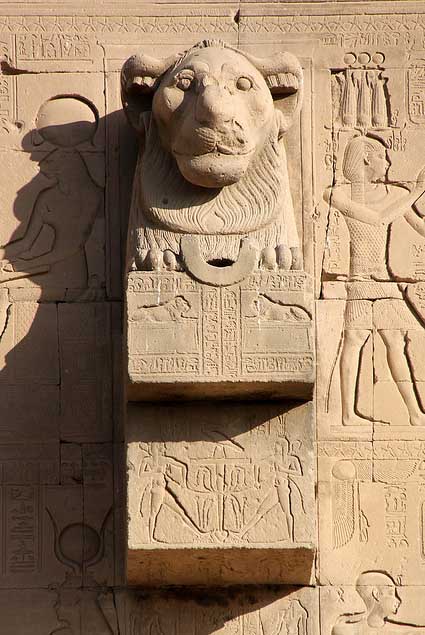
In Ancient Egyptian architecture, gargoyles showed little variation, typically in the form of a lion's head. Similar lion-mouthed water spouts were also seen on Greek temples, carved or modeled in the marble or terracotta cymatium of the cornice.
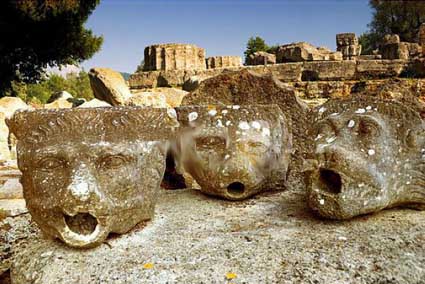
An excellent example of this are the 39 remaining lion-headed water spouts on the Temple of Zeus. There were originally 102 gargoyles or spouts, but due to the heavy weight (they were crafted from marble), many have snapped off and had to be replaced.
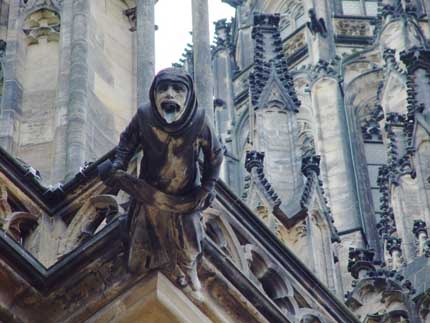
Many medieval cathedrals included gargoyles and chimeras. The most famous examples are those of Notre Dame de Paris. Although most have grotesque features, the term gargoyle has come to include all types of images. Some gargoyles were depicted as monks, or combinations of real animals and people, many of which were humorous.
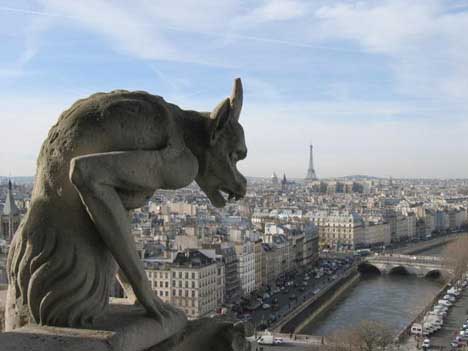
Unusual animal mixtures, or chimeras, did not act as rain spouts and are more properly called grotesques. They serve more as ornamentation, but are now synonymous with gargoyles.
Both ornamented and unornamented water spouts projecting from roofs at parapet level were a common device used to shed rainwater from buildings until the early eighteenth century. From that time, more and more buildings employed downpipes to carry the water from the guttering at roof level to the ground and only very few buildings using gargoyles were constructed.
In 1724, the London Building Act passed by the Parliament of Great Britain made the use of downpipes compulsory on all new construction.
Gargoyles were viewed two ways by the church throughout history. Often gargoyles were used to assist the Church in conveying messages to the common people. Due to literacy being uncommon, images were the best way to constantly convey ideas. Gargoyles were used as a representation of evil. It is thought that they were used to scare people into coming to church, reminding them that the end of days is near. It is also thought that their presence assured congregants that evil is kept outside of the church’s walls. However, some medieval clergy viewed gargoyles as a form of idolatry.
In the 12th century a church leader named St. Bernard of Clairvaux was famous for speaking out against gargoyles.
The ancient Egyptians, Greeks, Etruscans and Romans all used animal-shaped waterspouts. During the 12th century, when gargoyles appeared in Europe, the Roman Catholic Church was growing stronger and converting many new people. Most of the population at this time were illiterate, and therefore images were very important to convey ideas. In the medieval world many creatures had mystical powers attributed to them. Also, human qualities were sometimes ascribed to specific animals - that is, the animals were anthropormorphized. This was especially common for pagans, and using these ideas helped conversion to Catholicism. Some animals (such as the rhinoceros and the hippopotamus) were unknown in western Europe during the Middle Ages so gargoyles of these species (such as the ones at Laon Cathedral) are modern gargoyles and therefore did not have symbolic meaning in Medieval times. Below is a list of some animals commonly used as gargoyles, and some of the meanings behind them.
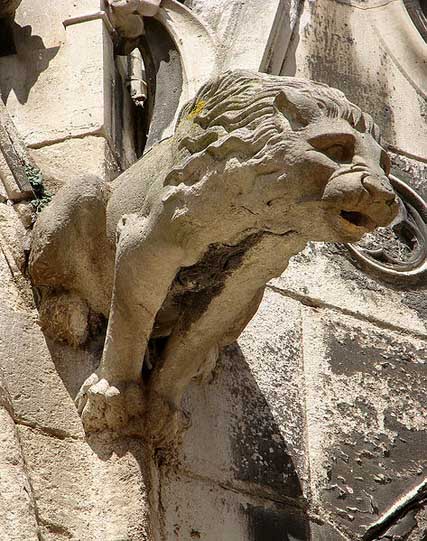
Gargoyle in form of a lion
Cathedral Saint-Etienne de Meaux.
Lions were the most common non-native animal crafted as a gargoyle in the medieval period. In ancient times, the lion was linked to the sun, most likely due to its golden mane bearing similarity to the solar wreath of the sun. Lion gargoyles were popular with the ancient Greeks and were frequently used on houses in Pompeii during Roman times. During the medieval period lions became the symbol of pride, one of the 7 deadly sins. Cats other than lions were rare among gargoyle carvings because of their dark nature and association with Satanism and Witchcraft.
Both lions and their female counterparts were a favorite choice for the makers of gargoyles. The lion was by far the most popular non-European animal to be used on churches and cathedrals in the middle ages. They were popular as gargoyles during older times (Pompeii is full of them) and they had symbolized the sun, with the golden mane representing the solar wreath of our life giving star.
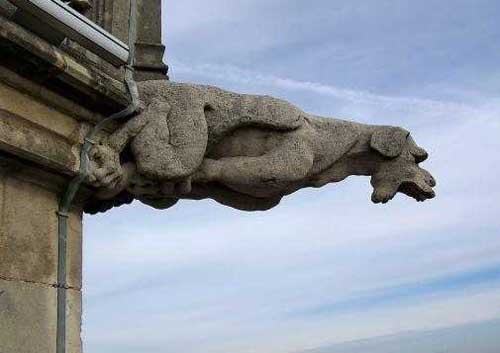
Dogs were the most common native animal crafted as a gargoyle. Dogs were seen as faithful, loyal, and intelligent, making them excellent guardians. They were, however, not without their faults. Their well-known hunger and tendency to steal food from kitchens showed that even dogs were vulnerable to the Devil's temptation.
This gargoyle above is found at the top of the Philippe le Bel tower in the ducal palace of Dijon again in France. As popular then as they are now, dogs were rarely kept simply as pets and were often given guardianship of a home at night. As such they were seen as clever, loyal and faithful. So on one point they can be seen as those stone animals given the role of protecting these buildings but there was another reason for their presence too. Dogs are always hungry and were often common thieves during these times and so were included on the sides of cathedrals to show that even such a faithful animal as the dog can fall prey to the temptation of the devil and commit the sin of greed.
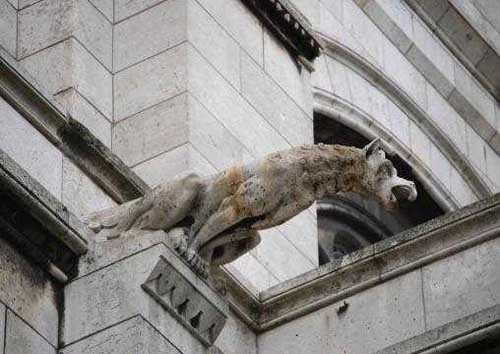
Although the wolf was a feared creature in medieval times, it was also respected. Wolves have the ability to live and cooperate as a pack which gave rise to the metaphor that a wolf could be a leader of a pack and protect the members. This was linked to priests who would fight off the evil of the Devil for the common folk. The wolf was also linked to the deadly sin of greed.
Returning to Paris and this time the Sacré-Coeur, here is a fine example of the wolf as gargoyle. Although wolves too were linked to greed they were respected as an animal that lived through cooperation with its peers – and they gave rise to the ancient metaphor ‘the leader of the pack’. They were also linked to priests whose responsibility it was to protect the people from the devil – so the wolf was the protector of the lamb of God, as it were. Gargoyles come in packs too – and this was because the architects needed to divide the flow of rainwater off the roof. A single gargoyle would not be much good in a ferocious storm. Their strange elongation is also deliberate as the extra length will ensure that the water cascades as far away from the wall as possible.
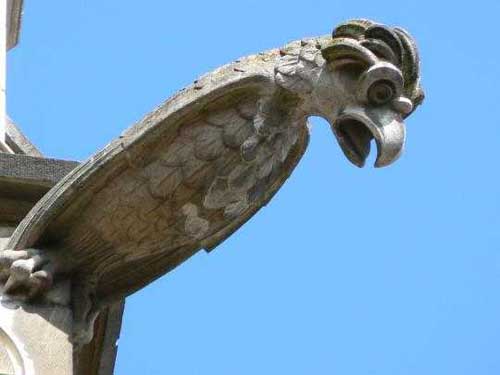
Large eagle as gargoyle on the Saint Rumbolds Cathedral in Mechelen, Belgium
A powerful bird who was said to be able to slay dragons. Eagles were respected for their ability to see far away objects, and were also said to renew themselves by looking into the sun (accounting for the glint always seen in the eagle’s eye in paintings).
These were protectors of the buildings, particularly against dragon as it was said that they were one of the few animals capable of destroying a winged serpent. They were also highly respected for the vision (which was again used as a metaphor and seen as foresight) and legend had it they had Phoenix like qualities. They were, it was said, able to heal themselves by looking directly in to the sun which itself is an ancient symbol of deity.
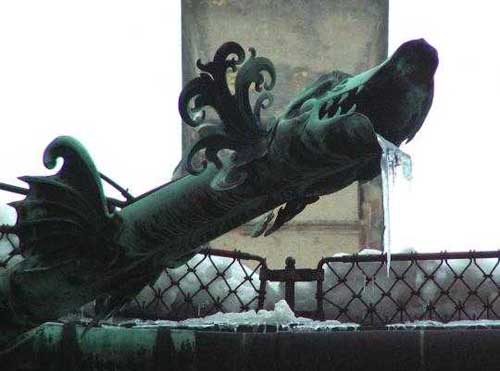
Krakow, Poland
From the story of Adam and Eve, the serpent represents a struggle between good and evil. The serpent was related to the deadly sin envy. They were also thought to be immortal due to the shedding of their skin. This gave rise to the symbol for immortality being the Ouroboros, a serpent with a tail in its mouth.
The serpent is associated with original sin and as such can be found (most often winged) all over the cathedrals of Europe. From the days of Adam and Eve the serpent has been the symbol for the continual struggle between good and evil. In terms of the seven deadly sins, the serpent represented envy. Scarily enough they were also thought to be immortal which meant that the daily struggle against the sins of the flesh would carry on for all eternity.
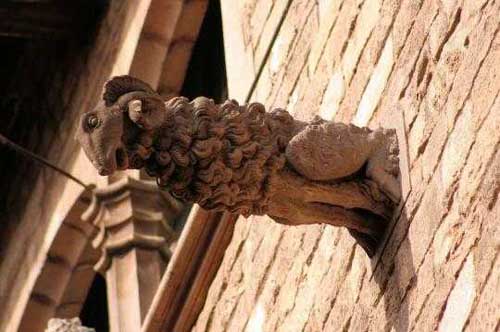
Barcelona Cathedral
he goat had two viewpoints in medieval times. One perspective was that the goat was equated with Christ due to its ability to climb steep slopes and find edible food. On the other side it was seen as a symbol for lust and even linked to Satan.
Like many of the animals featured here it had a duality of nature in the eyes of medieval Christians. On one side they were thought to be Christ-like because of their ability to find food on steep mountainsides and nourish themselves from almost nothing (the Feeding of the Five Thousand springs immediately to mind as a parallel). On the other hand they were seen as quite venal creatures and were often seen as a symbol of lust – yet another one of those seven deadly sins. Plus, of course, which animal would you associate with Satan?
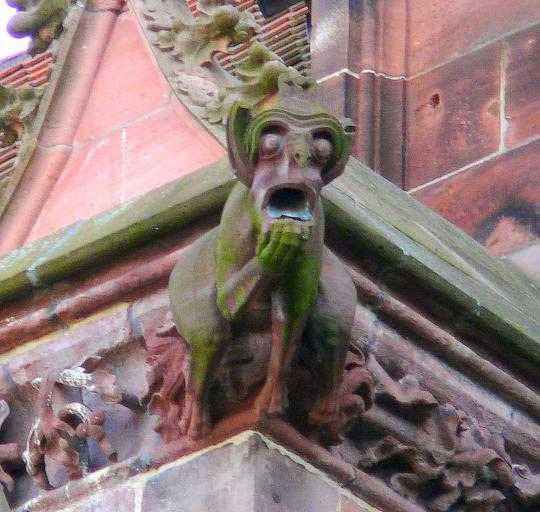
Monkeys were seen as what happened to humans when nature went awry. They were thought to be stupid creatures, and their intelligence was misrepresented as cunning. The monkey was linked to the deadly sin of ‘sloth’.
Although not designed to drain water and therefore technically not gargoyles, the grotesques on modern structures are still considered by most people to be gargoyles. Grotesques were used as decoration on 19th- and early 20th-century buildings in cities such as New York (where the Chrysler Building's stainless steel gargoyles are celebrated), Minneapolis, and Chicago. Gargoyles can be found on many churches and other buildings.
One extensive collection of modern gargoyles can be found in Washington National Cathedral in Washington, DC. The cathedral, begun in 1908, is encrusted with the limestone demons. This collection also includes Darth Vader, a crooked politician, robots and many other modern spins on the ancient tradition.
The 20th Century collegiate form of the Gothic Revival produced many modern gargoyles, notably at Princeton University, Washington University in St. Louis, Duke University, and the University of Chicago.